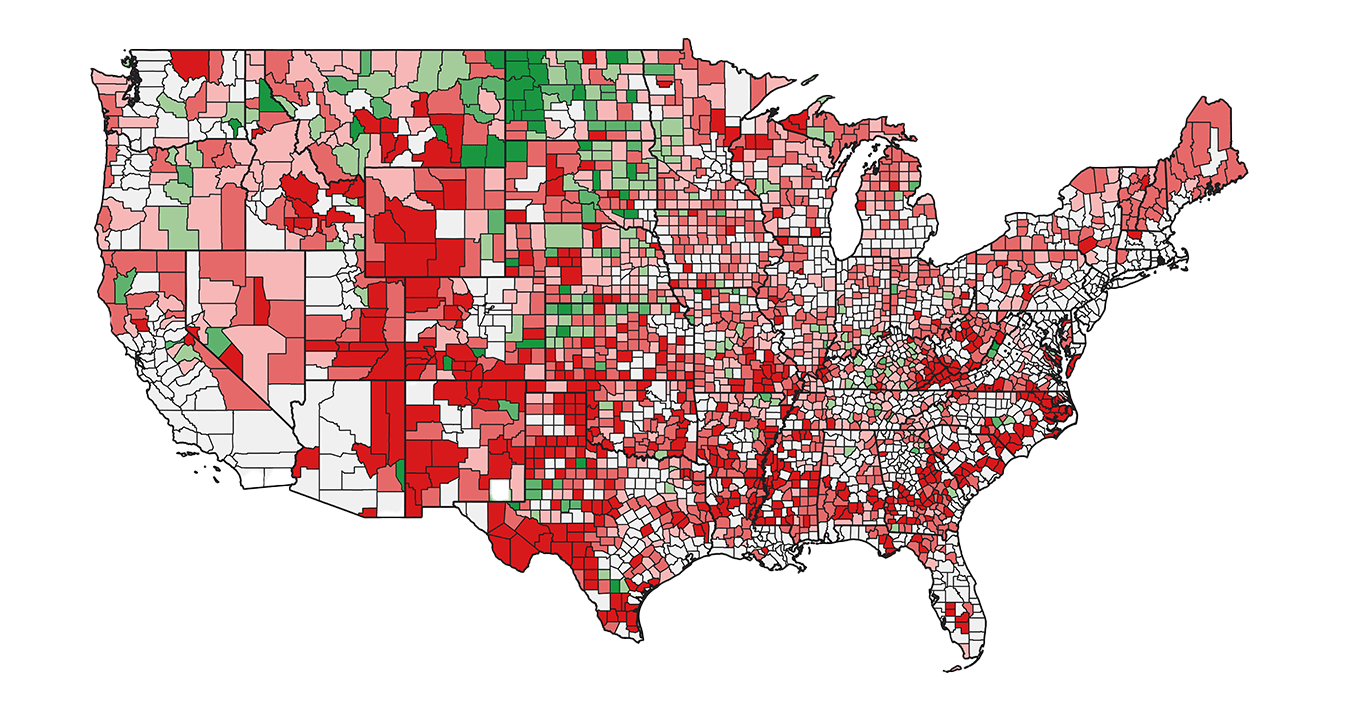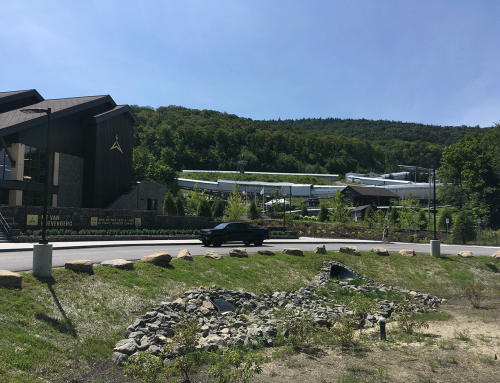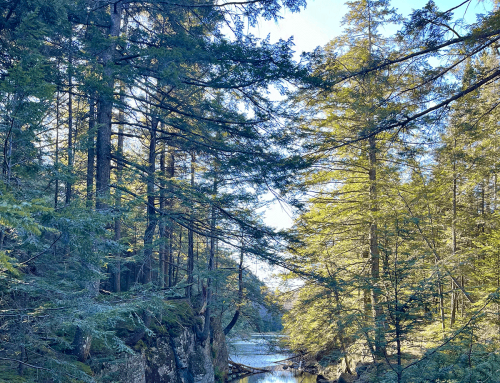Conversation in the Adirondack Park has long been dominated by the belief that local land use controls under the Adirondack Park Agency (APA) Act and the abundant public land mass in the Forest Preserve drive local population trends. This, of course, is a myth and not reality. There’s power in myths, and sometimes there’s truth in myths, but mostly there’s a lot of myth in myths. There is nothing unique or locally-inspired about the population trends in the Adirondack Park and North Country. No matter how much one may dislike the 52-year-old APA land use controls or the 139-year-old Forest Preserve, the population trends playing out today in the Adirondack Park and North Country are the same as those playing out across the great majority of Rural America.
The recently released data from the 2020 US Census lets us spotlight population realities in Rural America. As outlined in the 2019 report The Adirondack Park and Rural America: Economic and Population Trends 1970 to 2010, there are 1,941 “rural” counties in the U.S. Comparisons of Adirondack Park trends to averages or trends for New York State or the U.S. in general don’t tell us much, but comparisons with Rural America can tell us a lot.
The US Census has a variety of measures and criteria for classifying a county as “rural.” Based on Census classifications, 24 of New York’s 62 counties are considered “rural,” including seven of the 12 Adirondack Park counties such as Clinton, Essex, Franklin, Fulton, Hamilton, Lewis, and St. Lawrence. Other Adirondack Park counties may have large portions of rural areas, but they are within significant population (metropolitan) areas like Glens Falls-Saratoga Springs or the Herkimer-Utica-Rome area. From 2010 to 2020, only two of New York’s “rural” counties posted population gains – Hamilton County and Sullivan County.
The 2020 Census was noteworthy because it marked the first time in American history that half of U.S. counties saw population losses. Yet, even more striking, and pertinent to Adirondack Park communities, is that across Rural America the number was much higher, as 66% of all rural counties lost population. From 2010 to 2020, the U.S. population increased to over 334 million, gaining over 22 million Americans. At the same time, the population in the 1,941 counties in Rural America was stagnant and experienced a net loss of just under 37,000 residents, dropping from 47,767,634 in 2010 to 47,730,728 in 2020. The 1,941 counties of Rural America extend across 68% of the continental U.S. yet contain just 14% of the country’s population.
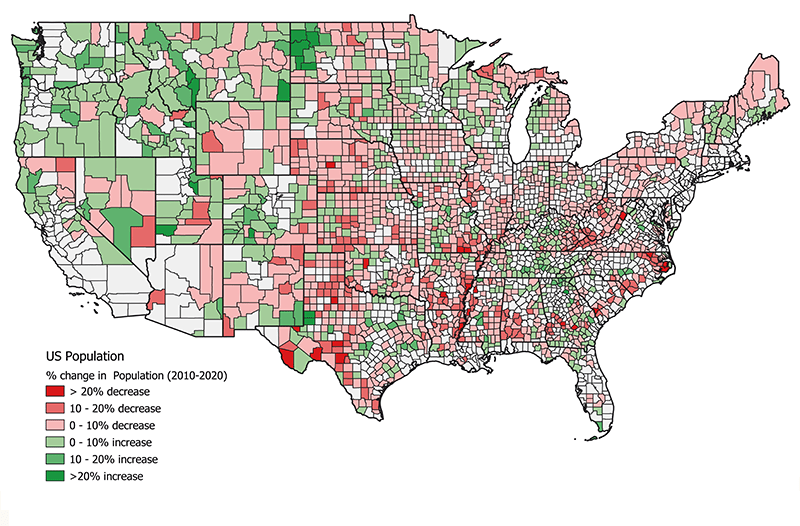
This map of the continental U.S. shows rural counties that gained or lost population from 2010 to 2020. 1,280 out of 1,941 rural counties, fully 66%, lost population in the last decade. White areas are metropolitan counties.
The 2020 US Census data for the 1,941 “rural counties” that constitute Rural America shows seven specific trends that mirror those playing out in the rural communities of the Adirondack Park and North Country. While many decry these trends as unique to the Adirondack Park, the data tells a much different story. From 2010 to 2020, the US Census found that among the 1,941 counties in Rural America:
- 88% experienced a decrease in children 0 to 4 years old. Collectively, Rural America lost over 371,000 people in this age cohort.
- 72% experienced a decrease in children 5 to 17 years old. Collectively, Rural America lost over 303,000 people in this age cohort.
- 72% experienced a decrease in young adults 18 to 24 years old. Collectively, Rural America lost over 292,000 people in this age cohort.
- 59% experienced a decrease in adults 25 to 34 years old. Collectively, Rural America lost almost 59,000 people in this age cohort.
- 67% experienced a decrease in adults 35 to 44 years old. Collectively, Rural America lost over 264,000 people in this age cohort.
- 88% experienced a decrease in adults 45 to 64 years old. Collectively, Rural America lost over 811,000 people in this age cohort.
- 96% experienced gains in adults 65 to 84 years old. Collectively, Rural America gained over 2 million people in this age cohort.
As shown above, the great majority of Rural America saw losses of children, young adults, and career-age adults yet made gains in retirement-age senior citizens. If this sounds familiar, it should, because these trends have been dominant for the last 40 years and are intensifying in the Adirondacks, Upstate New York, and throughout Rural America.
The post-World War II years saw an unprecedented growth in the U.S. population from 1945 to 1965. The famed Baby Boom generation is now almost fully entering senior citizen status. The Baby Boom population explosion was especially prevalent in Rural America, where millions of children were born and raised, but who then left Rural America in droves as young adults in the 1960s, 1970s and 1980s for life in America’s cities and suburbs. The Baby Boom population explosion filled rural schools for decades, as Baby Boomers moved from elementary school to High School, but this generation moved away in great numbers during their working lives. The Adirondacks shared in this rural population explosion and we’re now sharing in its contraction as population patterns in the U.S. have markedly shifted.
The exodus from Rural America over the last 50 years has created a seemingly enduring trend in American life where the bigger population areas are getting bigger and smaller population areas are getting smaller.
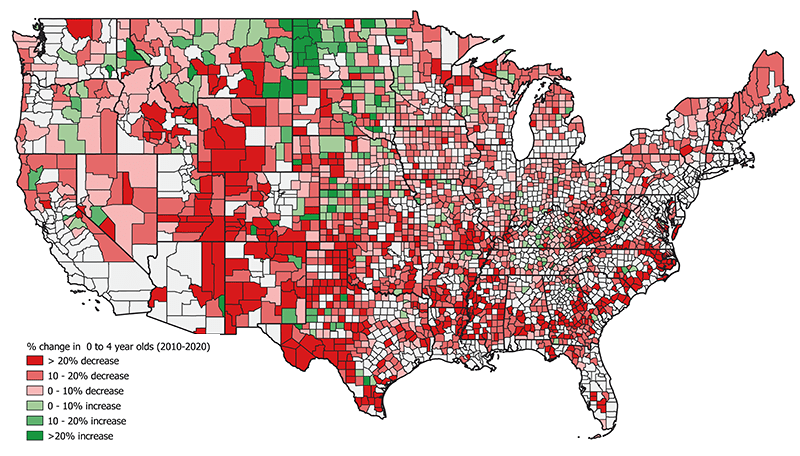
This map of the continental U.S. shows rural counties that gained or lost populations of children 0 to 4 years old from 2010 to 2020. 88% of the counties in Rural America lost population in the last decade. White areas are metropolitan counties.
Just look at the top 100 counties/places by population in the U.S., from Number 1 Los Angeles County, with over 10 million residents, to Number 100 District of Columbia, with over 689,000 residents. Among the top 100 largest counties in the U.S., 97 counties saw population growth from 2010 to 2020. The top 100 counties gained over 12 million new residents, more than one-half of the country’s total gain in the last decade, and in 2020 these places were home to over 40% of the total U.S. population. Only 12 of the top 200 counties by population in the U.S. saw population losses 2010 to 2020, while the Top 200 combined for growth of 16.6 million new residents, 75% of the country’s total gain, and in 2020 were home to 57% of the U.S. population. Just 6% of U.S. counties held 57% of the U.S. population. The top 13 counties in the U.S. by population had 50 million residents in 2020, which is more residents than all of Rural America combined.
The trend of big places in the U.S. getting bigger has been a dominant trend in American life for decades and is now intensifying. The flip side of big places getting bigger is that small places are getting smaller. The smallest 500 counties by population in the U.S. combined for a loss of 93,000 people from 2010 to 2020. These are mostly places like Hamilton County in the central Adirondacks. According to the US Census, Hamilton County had 5,100 residents in 2020. The 500 smallest counties in the U.S. range from Chouteau County in Montana, with 5,895 residents, to Loving County in Texas, with a population of 64. The smallest 1,000 counties in the U.S. by population had 8.3 million residents in 2020, less than Los Angeles County, and from 2010 to 2020 experienced a net loss of 372,000 residents. By contrast, LA county gained 195,000.
These population trends in the U.S. are especially acute for Rural America in general and our corner of Rural America here in the Adirondack Park in particular. One trend to note is that while the 1,941 counties of Rural America saw drops in their populations under age 65 from 2010 to 2020, their population of residents at age 65 years old and older jumped by 31%, increasing by over 2 million. This growth stems from an older population aging in place and from the high number of people who grew up in Rural America, who left their hometowns for careers in other places, and have returned as retirees.
The growing high population of older residents is a wave that is unlikely to crest anytime soon, but it will eventually play out as many in our large senior population will not be here in 20 or 30 years. If present trends continue, the reality of smaller and smaller cohorts of children and young adults, combined with the mortality of Baby Boomers, will continue to steadily shrink populations of small communities across Rural America decade after decade. These trends will be difficult for individual communities to alter or reverse, and they will continue to shape and reshape rural areas like the Adirondacks and North Country, as well as many other small communities, for decades to come.
Blaming the APA or the Forest Preserve may feel good, and it may even have some political benefits, but it’s a chronic misdiagnosis of our population challenges, and it does nothing to help us understand the root causes of our local population trends or where we’re heading in the future. If we do not understand the realities of American life in 2024 that drive our national and regional population trends, our efforts to manage these changes and build stronger and more vital communities, even as we get smaller, will be unsuccessful.

